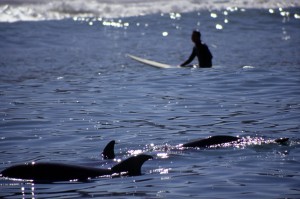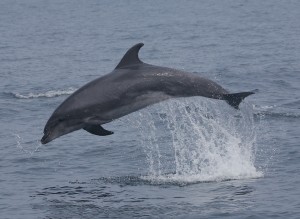
Photo credit: Maddalena Bearzi
Finally, you left the security of your beach towel to take a dip in the ocean and now you’re swimming and wondering why you wasted so much time on the sand. But wait, is that a fin?
Trying to remain calm, you pray you didn’t see anything.
There it is again, the fin is closer, it’s coming right towards you! The creature’s head rises out of the water and you see…a smile.
It’s a dolphin! And most likely it’s a Bottlenose Dolphin, sometimes mistaken for sharks by swimmers and SCUBA divers who are initially caught off guard by their large size and their tendency to travel individually or in small groups. Tursiops truncatus, the scientific name for Common Bottlenose Dolphins, average 10 to 13 feet in length as adults and are a grayish color, but sometimes have a bluish tint, depending on your vision, the lighting and your proximity.
The Bottlenose Dolphin’s mostly uniform gray coloring is one way to tell them apart from Common Dolphins who have cream patches on their sides and Pacific White-Sided Dolphins who have, as you might have already guessed, white sides and a white and dark gray dorsal (back) fin. But if you see a dolphin in the surf, it’s most likely a Bottlenose Dolphin because they are typically the only dolphins that come that close to shore. And in case you were wondering dolphins are distinct from porpoises. Dolphins have a curved dorsal fin, a beak (most of the time) and cone-shaped teeth while porpoises have a triangular dorsal fin, no beak and spade-shaped teeth.
Mention the word “dolphin” to anybody and nine times out of ten the image of the Bottlenose will pop into their heads. Five Bottlenose Dolphins were captured to play the part of Flipper in the television series and now Bottlenose Dolphins entertain audiences across the world at marine parks and Sea World like institutions.
But Bottlenose Dolphins are so much more than clown tricks and circus games. They know things.
The Ocean Conservation Society has been studying Bottlenose Dolphins in Santa Monica Bay for the last 13 years and has identified 647 distinct individual Bottlenose Dolphins using photos of every dolphin’s dorsal fin. Each fin has unique scratches, nicks or marks allowing each dolphin to be identified.
The dolphins fall into two main groups: 375 are coastal, living near-shore and 241 are offshore Bottlenose Dolphins who prefer deeper water further from the coast. Then there are about 31 who have been spotted close to shore and offshore, seeming to be more flexible than the rest.
By following dolphins and observing and recording their behavior from the organization’s boat, lead researcher Maddalena Bearzi has seen the ordinary and the extraordinary.
Ordinary activities include bowriding (when dolphins ride the waves created by the bow of the boat) and eating. Dolphins circle and trap fish cooperatively, taking turns snacking on tasty sardine delights. It was while watching the ordinary that Bearzi witnessed the extraordinary.
“The nine dolphins we were following had just started feeding on sardines after trapping the fish in a tight circle,” said Bearzi. “Then all of a sudden one of the dolphins in the group left the circle and started swimming offshore at a high speed. In less than an instant, the other dolphins left the sardines to follow.”
Dolphins suddenly making a bee line for deeper water, strange. Dolphins abandoning dinner, never!
Bearzi turned Sherlock and followed the dolphins’ trail hoping to find some clues to this unusual behavior. After pursuing the dolphins for nearly three miles, Bearzi and her team noticed that they had stopped swimming and formed a circle.
As Bearzi’s boat approached, one of her research assistants spotted blond hair floating in the middle of the circle—it was a person!
“Once we got closer, I maneuvered the boat inside the dolphin’s ring and yelled to the girl asking her if she was OK,” said Bearzi. “But she looked at us without any type of response and we decided we needed to get her in the boat. When we pulled her in she was fully dressed and so pale, her lips were blue.”
As they headed back to port, Bearzi noticed that the dolphins were gone. Later the doctor told Bearzi that if they hadn’t found the girl she would have surely died. (For all the details of this story read Bearzi’s book Beautiful Minds: The Parallel Lives of Great Apes and Dolphins.)
Some might brush aside this situation to coincidence. But seriously, coincidence? Let’s think about this. A pod of dolphins busy eating sardines suddenly take off in the same direction and then happen to find a drowning girl in the ocean three miles later. Coincidence, I think not!
So the next time you go swimming and see a curved dorsal fin bobbing along don’t panic. If there are two or more it’s most likely a pod of Bottlenose Dolphins just moving along, hunting for food, keeping watch along the shore.

Leave a Reply